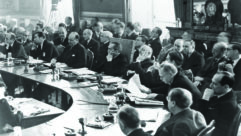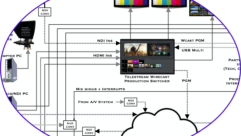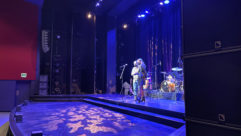
Keeping On The Grid
Video display wall helps San Francisco-based electrical utility know where its watts are.
CHALLENGE: Replace an electrical utility’s conventional map-board display system with a large video wall without altering the footprint of the operations room.
SOLUTION: Cut into a metal structure that used to house the map board, altering it so that it can accommodate the display wall and its accompanying equipment rack.
In his effort to monitor an electrical grid that spans from Southern California to the Oregon border, Pacific Gas & Electric operator Wes Kellison is aided by data displayed on 2×9 DLP video wall that is powered by a Jupiter Fusion 960 processor.
Credit: Skye Coddington, Skybeam Photography
A MANUFACTURER of display-wall processors, Hayward, Calif.-based Jupiter Systems saw its revenue increase 60 percent last year.
Helping drive this growth are robust sales in the domestic electrical utility industry, which is still feeling the affects of the massive cluster of power outages that hit the Northeast in August 2003, according to John Stark, director of marketing for Jupiter. He says that many of these utilities have upgraded their command-and-control environments from static, LED-based monitoring systems to dynamic, video-wall displays to better monitor their massive power grids.
These video displays let operators survey their lines in XGA resolution, zooming in on potential problems on the grid that are reported in real time by network management software systems, which can be updated on the fly.
The power outages four years ago proliferated in domino-effect fashion, with one failing grid taking down another. Stark says it might have been avoided if utility operators then had tools that would help them better understand the big-picture situation, and trip the correct switches to keep their networks from getting zapped. “If they had the tools to better see [the situation], they might have been able to avert disaster,” says Stark.
San Francisco-based Pacific Gas & Electric recently acquired such tools, contracting Mauell-U.S., a Dillsburg, Pa., company that specializes in command-and-control system integration for utility companies, to convert the static, LED-based, map-board monitoring system in its transmission operations center into a new, two-by-eight display wall featuring 16 Mitsubishi VS-50XL50U50-inch rear projection DLP cubes and a Jupiter Fusion 960 display-wall processor.
“We really needed to get into the 20th century,” says Bruce Henry, manager of PG&E’s transmission operations center, explaining the impetus for the $400,000 AV upgrade. “Our old, static board displayed circuit-breaker status as a red light or green light only. We needed to upgrade to a video-based system that was totally malleable and could present any kind of data our operators need.”
In fact, the operations center’s software backbone was programmed with video display in mind. All PG&E needed to do was provide the hardware. To get it, the company put out an request for proposals three years ago before deciding to go with Mauell-U.S., a subsidiary of Germany’s Mauell with extensive infiltration into the U.S. utilities command-and-control market.
According to Gary Suchy Jr., program manager for Mauell, the integrator’s work for PG&E was based on a fairly simple AV system. The Fusion 960 is connected directly to and controlled by the operations center’s energy management software. It then feeds the Mitsubishi monitors via an assortment of Kramer male-to-male DVI cables.
“In terms of electronics, there’s not a lot here,” says Suchy. “There are no distribution amps or anything like that. It’s just a straight plug-and-play system.”
INTEGRATOR HANDLES STRANGE BOX WITH CARE
In terms of wiring AV components, building a display wall for utility client PG&E was a fairly straightforward task for Mauell-U.S. But the company faced a common challenge to integrators working in the command-and-control spaces: dealing with proprietary electronics that fall far out of the purview of the typical AV systems contractor.
For PG&E’s transmission operations center, Mauell engineers sought to reconfigure a large metal fixture in the middle of the room, remove the static, LED-based monitoring board that was previously attached to it, and embed a display wall inside.
In the process, certain other mission-critical components that were also embedded into this structure, such as a 36-alarm annunciator box that alerted PG&E officials to failures on their electrical network, had to be moved to make room for the display wall.
“There were no manuals or history on this piece of equipment,” notes Mauell Program Manager Gary Suchy Jr. “The last thing we wanted to do is to turn it on after we moved it and have it short out.”
Before unplugging anything, Mauell engineers sought insight into the strange box not only from PG&E officials, but also from the California Independent System Operator, which manages the state’s high-voltage lines.
“We decided early on that we didn’t want to splice any cables or add any new ones,” says Suchy. “We wanted to create an unplug and replug application.”
Doing this required that each wire — “There were a few hundred cables that went into this thing,” says Suchy — be measured carefully to make sure it could span the length needed to reach the accentuator’s new position at the far right of the structure. (It was previously located in the center of the piece.) Mauell officials also had to meticulously label each wire and its corresponding plug.
The whole process took a couple of days, but the extra care ensured that Mauell didn’t short out a mission-critical device that the integrator had no idea how to replace.
“One of the most difficult aspects of the job was moving that thing,” says Suchy. “We held our breath when we turned it back on. But when we did, it was still receiving signals from the field and working fine.”
In terms of AV products, Suchy says that 50-inch Mitsubishi DLP cubes “were the best fit for the room from a standpoint of sight lines and viewing angle. … At the time, it was the only product on the market that had ‘smart lamp’ technology, in which the projection engines talk to each other to make sure the wall has uniform color temperature and brightness.”
While the AV component installation was fairly straightforward, the construction and design aspects of the job were far more challenging. PG&E operators wanted the video wall to occupy the same basic footprint of their previous static display. This required Mauell to cut into and encase its video wall inside a large, curved steel enclosure in the center of the room that previously housed the old, LED-based board, preserving the structure’s beige finish and trim.
“Our technology hurdle was to integrate a cube-based system that would fit within the foot-print of the map-board enclosure,” says Suchy. “A lot of work was done on the front end in terms of engineering. We did our homework on this one.”
The video wall had to be mounted securely to meet the Bay Area’s stringent seismic codes, a process made more difficult by the fact that the presence of asbestos made it hazardous to cut into the ceilings. Because of budget reasons, the project was cut into two phases. First, Mauell integrated a 12-display-cube wall into the structure 18 months ago; then late last year, it expanded it into a 16-cube wall.
Meanwhile, the mission-critical nature of the operations center’s work required Mauell installers to work quickly and leave a small footprint, so that PG&E staffers could continue to monitor a 70,000-square-mile services area, running from Eureka to Bakersfield and encompassing about 190,000 miles of transmission lines.
“This job was engineering intensive,” says Suchy.
Adds Henry, “We operate in a mission-critical environment, and we don’t have the ability to just tell our folks, ‘You’re going to be blind while we upgrade the system.’ We wanted to make sure that as we transitioned, we had continuity of data.”
To get things started, PG&E staffers visited a local home-improvement supply store and bought copious amounts of plastic painter’s sheeting, which was then hung from the ceiling to enclose the work area. This let the operators monitor a 500-kilovolt electrical network via local workstations, with limited intrusion from dust at the job site. The initial phase of the project took about two and a half weeks.
“We worked without the big view on our individual screens,” says Henry, noting that much of the work was done during nonpeak hours of power consumption.
Once a working protocol was devised, Mauell went about reinventing the large, freestanding metal enclosure, which measures 108 inches tall, 336 inches wide and 25 inches deep. In addition to housing the center’s map board, this structure also encased several electronic components, including an annunciator box, which is designed to alert PG&E operators in the event of a voltage problem. Several television sets were mounted in the enclosure, so that network operators could monitor cable news sources, including CNN and the Weather Channel, a service that the new display wall now handles.
No audio gear was supplied as part of the new system. PG&E had its DVD/VCR player, as well as the TV tuner inside of it, hooked up to a zone speaker system in the operations room ceiling before Mauell’s arrival, and the integrator kept that configuration intact.
All that equipment had to be moved to another portion of the structure to make way for the video wall. “We had to disconnect it all, sort out a rat’s nest of wiring, then get it working again,” says Dave Leppo, a Mauell mechanical engineer.
Once the equipment was moved over, Mauell plied its Portaband saw to the structure, slicing away huge portions of the face and back to create a viewing area for the video wall, as well as service doors for an equipment rack and individual monitors.
To mount the monitors, Mauell custom-built a rack, welding a cage of 14-gauge tube steel. The curved rack then fit neatly inside the large steel enclosure. Custom racks were also created for the Fusion 960, as well as DVD and VHS players provided by PG&E that are used for training. These devices were placed at the far end of the enclosure behind smoke-glass doors built into its face. According to Leppo, several cooling fans were mounted inside the enclosure to keep the Mitsubishi display cubes from overheating.
Working in the heart of earthquake country, Mauell was required to anchor the video wall rack to the concrete floor using 3/8-inch threaded rods. Seismic code also called for the rack to be ceiling mounted, but the asbestos issue made installers hesitant to cut into the ceiling.
However, the large metal enclosure already was anchored to a unistrut in the ceiling. This let engineers simply attach the video wall rack to that same anchor point.
According to Henry, the system has been glitch-free so far. “It’s really given us total flexibility,” he says. “We typically have about six or eight windows open on the display at any given time to show us critical data from various points of our system. That has let us work in a closer fashion and make decisions in a more integrated way. It’s really enhanced our visibility and our decision-making ability.”
FOR MORE INFORMATION
- Jupiterwww.jupiter.com
- Mitsubishiwww.mitsubishi-tv.com
- Kramerwww.kramerelectronics.com
Meanwhile, with many electrical utilities still under scrutiny for being undermodernized — in the wake of the Northeast blackouts, former Energy Secretary Bill Richardson told CNN, “We’re a superpower with a third-world grid” — such AV amenities can serve a political purpose, too.
“It is a visible reminder that [utility operators] are doing all they can to make sure there is a stable power supply that’s being managed in an efficient way,” says Stark.
Daniel Frankel is a freelance writer based in Los Angeles. He can be reached at [email protected].










